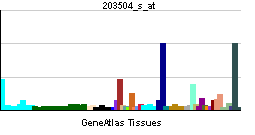ABCA1
| ATP-binding cassette, sub-family A (ABC1), member 1 | |||||||||||
|---|---|---|---|---|---|---|---|---|---|---|---|
| Identifiers | |||||||||||
| Symbols | ABCA1 ; ABC-1; ABC1; CERP; FLJ14958; HDLDT1; TGD | ||||||||||
| External IDs | Template:OMIM5 Template:MGI HomoloGene: 21130 | ||||||||||
| |||||||||||
| RNA expression pattern | |||||||||||
 | |||||||||||
 | |||||||||||
| More reference expression data | |||||||||||
| Orthologs | |||||||||||
| Template:GNF Ortholog box | |||||||||||
| Species | Human | Mouse | |||||||||
| Entrez | n/a | n/a | |||||||||
| Ensembl | n/a | n/a | |||||||||
| UniProt | n/a | n/a | |||||||||
| RefSeq (mRNA) | n/a | n/a | |||||||||
| RefSeq (protein) | n/a | n/a | |||||||||
| Location (UCSC) | n/a | n/a | |||||||||
| PubMed search | n/a | n/a | |||||||||
ATP-binding cassette transporter ABCA1 (member 1 of human transporter sub-family ABCAis a human protein and gene. This transporter is a major regulator of cellular cholesterol and phospholipid homeostasis.
The membrane-associated protein encoded by this gene is a member of the superfamily of ATP-binding cassette (ABC) transporters. ABC proteins transport various molecules across extra- and intracellular membranes. ABC genes are divided into seven distinct subfamilies (ABCA, MDR/TAP, MRP, ALD, OABP, GCN20, White). This protein is a member of the ABCA subfamily. Members of the ABCA subfamily comprise the only major ABC subfamily found exclusively in multicellular eukaryotes. With cholesterol as its substrate, this protein functions as a cholesterol efflux pump in the cellular lipid removal pathway. Mutations in this gene have been associated with Tangier's disease and familial high-density lipoprotein deficiency.[1]
References
Further reading
- Oram JF (2003). "ATP-binding cassette transporter A1 and cholesterol trafficking". Curr. Opin. Lipidol. 13 (4): 373–81. PMID 12151852.
- Hong SH, Rhyne J, Zeller K, Miller M (2003). "ABCA1(Alabama): a novel variant associated with HDL deficiency and premature coronary artery disease". Atherosclerosis. 164 (2): 245–50. PMID 12204794.
- Kozak M (2003). "Emerging links between initiation of translation and human diseases". Mamm. Genome. 13 (8): 401–10. doi:10.1007/s00335-002-4002-5. PMID 12226704.
- Joyce C, Freeman L, Brewer HB, Santamarina-Fojo S (2004). "Study of ABCA1 function in transgenic mice". Arterioscler. Thromb. Vasc. Biol. 23 (6): 965–71. doi:10.1161/01.ATV.0000055194.85073.FF. PMID 12615681.
- Singaraja RR, Brunham LR, Visscher H; et al. (2004). "Efflux and atherosclerosis: the clinical and biochemical impact of variations in the ABCA1 gene". Arterioscler. Thromb. Vasc. Biol. 23 (8): 1322–32. doi:10.1161/01.ATV.0000078520.89539.77. PMID 12763760.
- Nofer JR, Remaley AT (2005). "Tangier disease: still more questions than answers". Cell. Mol. Life Sci. 62 (19–20): 2150–60. doi:10.1007/s00018-005-5125-0. PMID 16235041.
- Yokoyama S (2006). "ABCA1 and biogenesis of HDL". J. Atheroscler. Thromb. 13 (1): 1–15. PMID 16505586.
- Schmitz G, Schambeck CM (2006). "Molecular defects in the ABCA1 pathway affect platelet function". Pathophysiol. Haemost. Thromb. 35 (1–2): 166–74. doi:10.1159/000093563. PMID 16855366.
| This protein-related article is a stub. You can help Wikipedia by expanding it. |